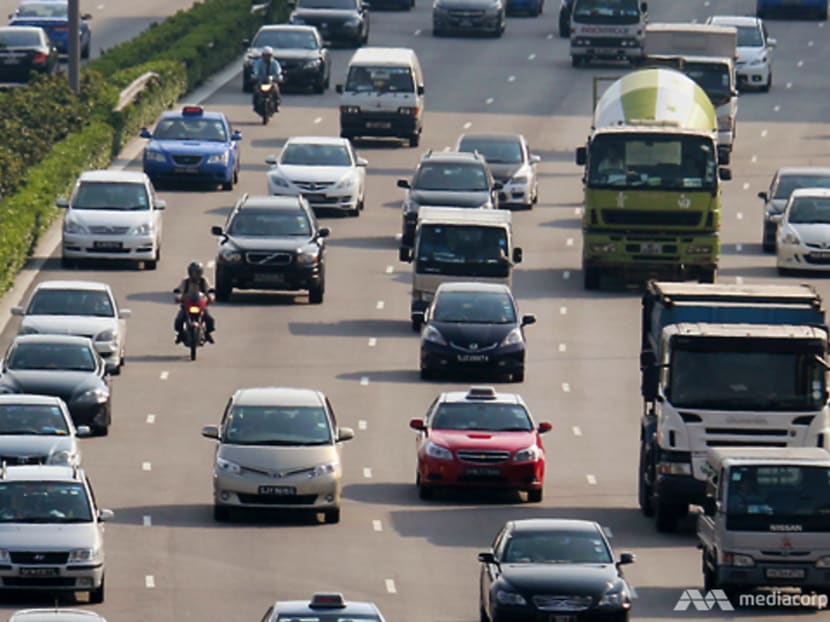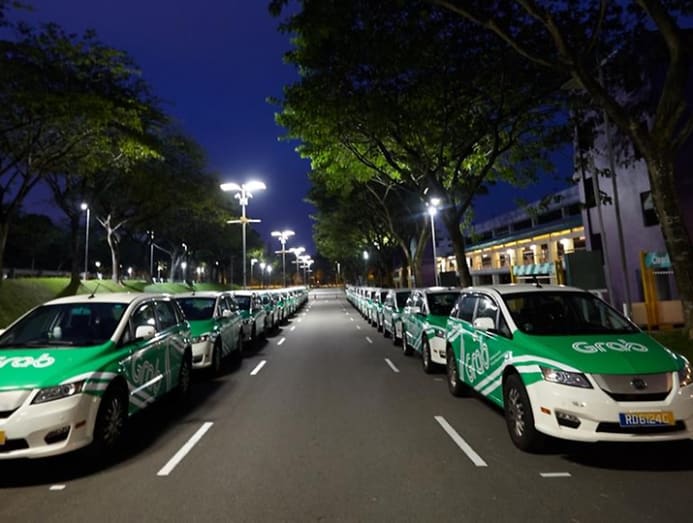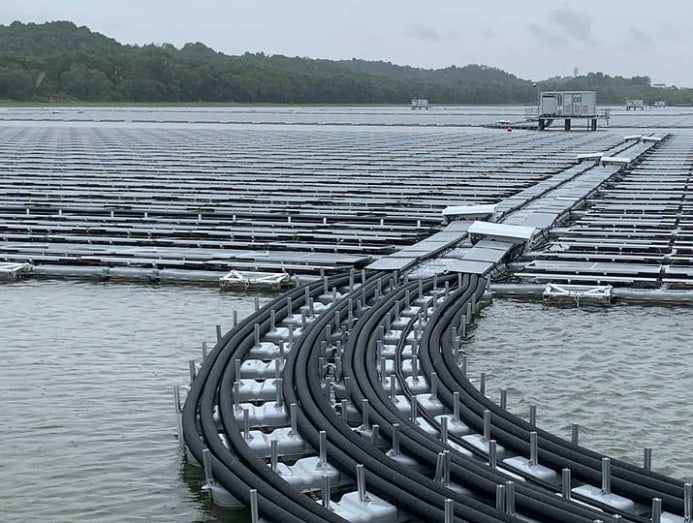Commentary: How ride-hailing will change to help countries meet climate goals
Transport is among the biggest contributors of greenhouse gas emissions. We must look at the entire network of vehicles and rethink how they’re powered, says Grab’s Andrew Chan.

File photo of cars in Singapore. (Photo: Mediacorp)
SINGAPORE: Weather forecast: Heatwaves and coastal floods for Singapore if global greenhouse gas emissions aren’t reduced to net-zero by around 2050.
As the recently published Intergovernmental Panel on Climate Change (IPCC) report states, human activities have been responsible for about 1.1 degrees Celsius of warming.
And, unless there are immediate, rapid and large-scale reductions in greenhouse gas emissions, limiting warming to 1.5 degrees Celsius or even 2 degrees Celsius will be beyond reach.

As major players in the mobility sector who operate large fleets of vehicles, ride-hailing companies must act urgently.
They must adopt vehicles that run on cleaner energy, while aiming to neutralise current levels of emissions. An electric vehicle (EV) generates only about half of an Internal Combustion Engine (ICE) vehicle’s carbon emissions over its lifetime.
While ride-hailing accounts for only about 4 per cent of Singapore’s land transport emissions, the sector is set to grow if worldwide trends are any indication. A Mordor Intelligence report projected that the global ride-hailing industry could double to be worth US$230 billion by 2026.
Like the demand for public transport, appetite for ride-hailing won’t go away. But shifting consumer priorities may reshape this industry. A survey of almost 9,000 Grab users across six Southeast Asian countries show 82 per cent of respondents expressed concern about climate change and wanted to act to reduce their carbon footprint.
Just as ride-hailing companies support ride-pooling, they must also electrify their fleets. The Union of Concerned Scientists estimates that an electric, pooled ride-hailing trip reduces carbon emissions by 68 per cent compared to a private car trip.
Ride-hailing companies worldwide are doing their part. Since 2017, China’s Didi – which claims to operate the world's largest EV fleet of about 1 million – has been building its own EV-charging infrastructure.
Uber too has pledged that all rides globally will take place in zero-emission vehicles by 2040.
In Singapore, under Grab’s Transport Sustainability Goal, the firm is committed to operating a full fleet running on cleaner energy by 2030, and has already invested more than US$200 million to build up its electric and hybrid vehicle fleet through GrabRentals.
With the JustGrab Green service, customers can opt to ride in vehicles that emit less carbon emissions. Rides cost the same as the most frequently used JustGrab service in Singapore, removing cost concerns, and making it easier for consumers to choose green.
ELECTRIC VEHICLES CAN GET GREENER
But to drive large-scale changes in mobility, we must look at the entire network of vehicles and how they are powered. Transport is among the biggest contributors of greenhouse gas emissions in the world and accounts for 14 per cent of Singapore’s total emissions, according to the National Environment Agency’s (NEA) 2018 figures.
As it is, public buses in Singapore are going greener. The Government announced in March 2020 that it will buy only electric or hybrid buses, in line with its goal to have them run on cleaner energy by 2040.
But EVs can get greener. Persistent business and technological innovation around them can help reduce emissions.
For one thing, carbon is already emitted in the manufacture of EVs’ lithium-ion batteries, even before cars roll off the assembly line. About 25 per cent of an electric car's lifetime emissions come from battery manufacturing. The process is resource intensive, expending large amounts of water and rare earth materials.
Only 5 per cent of lithium-ion batteries are currently recycled. As their demand increases, the industry must identify more uses for spent batteries beyond their lifespans in vehicles.
What do the findings of the latest IPCC report mean for us? Find out on The Climate Conversations:
Singapore’s e-waste management system, regulated by the National Environment Agency (NEA), puts the onus on companies that import or manufacture hybrid cars and EVs, along with those supplying EV batteries, to collect and recycle end-of-life batteries.
E-waste recyclers, such as SMCi and TES, have set up lithium-ion battery recycling facilities here to process batteries of hybrid and electric vehicles. The recycling process focuses on recovering precious metals such as cobalt, copper and lithium to make new batteries and other products.
These are important steps, but creating efficient recycling systems remains difficult because batteries differ in chemistry and construction.
GETTING ELECTRIC VEHICLES TO RUN ON RENEWABLES
So long as EVs rely on electricity produced using fossil fuels, they still leave some carbon footprint. They can only become more effective by drawing on clean energy sources.
Driving an EV in the US, which relies heavily on fossil fuels for energy production, is likely to release more CO2 into the atmosphere than driving the same vehicle in Iceland, which runs almost entirely on hydroelectric, geothermal and solar energy.
As outlined in the Green Plan 2030, Singapore seeks to increase its use of renewable energy and expand its solar capacity about five times by 2030, enough to power about 350,000 households a year or supply around 3 per cent of the country’s total electricity consumption.
Innovative solar deployment can make a difference. The Sembcorp Tengeh Floating Solar Farm – a floating solar photovoltaic (PV) system on Tengeh Reservoir containing 122,000 solar panels – can generate enough clean energy to power Singapore’s five local water treatment plants.

The hope is that electric vehicles can likewise tap on renewable energy in Singapore in the near future.
NEED TO CONTINUE DRIVING GREEN TRANSPORT
Ride-hailing companies, transport operators and EV infrastructure have nonetheless advanced over the past decade in Singapore.
Along with incentives encouraging the use of EVs, there have been improvements in the charging infrastructure, making their adoption much easier than just seven years ago.
If Norway’s success is anything to go by, regulatory support can speed up uptake. Rebates can incentivise adoption and additional fees can be imposed on ICE vehicles.
Car manufacturers too must prioritise EV development in their business roadmaps and improve on their product specifications, including battery lifespan, maximum speed and recyclability.
Drivers themselves should embrace the switch to EVs and improve their etiquette during the charging process.
To support them, we need to further expand the charging infrastructure and shorten waiting lines. Chargers are also needed at high-traffic locations such as malls and hawker centres.
The pandemic’s lessons are still in our rear view. When COVID-19 halted global travel in 2020, we witnessed clearer skies and cleaner air and water. Global carbon emissions in the first quarter of 2020 were over 5 per cent lower compared to the first quarter of 2019.
But by the end of 2020, things reverted. As travel resumed, emissions in December 2020 were 2 per cent higher than that in December 2019, negating the pandemic’s ecological gains.
Positive impact is extremely fragile and needs maintenance. Governments, businesses and consumers need to act on their shared conviction and supercharge green mobility initiatives.
Andrew Chan is Managing Director, Transport at Grab Singapore.







